-
Test your knowledge: 3 fun French invention facts
Explore the intriguing stories behind three French innovations: the first camera phone photo, Napoleon's canned food solution, and the evolution of the pencil
-
French ‘flying man’ Franky Zapata crashes during Channel-crossing attempt on air scooter
He was trying to make a return journey between France and England using his latest invention
-
French school friends design tilting chair to help with mobility issues
Seeing an elderly family member struggle to get out of his seat inspired two friends to create the Alyzée
How sniffer dogs and ‘catch cups’ help fight against bedbugs in France
Innovative methods are being introduced to detect and eradicate infestations during ‘major upsurge’

Bedbugs had practically disappeared from France during the 1950s due to the use of strong pesticides that are now banned, but they have made an unwelcome comeback.
Between 2017 and 2022, more than one in 10 French households was affected, a survey by the French health and safety agency Anses has revealed.
Emmanuel Grégoire, one of Paris’s deputy mayors, has proposed adding the risk of bedbugs to standard home insurance policies. Separate policies already exist.
He also called for the organisation of a pest control conference to contain what he called a “major upsurge”.
Read more: Insure your French home against bed bug misery for €2 per month
Why are bedbugs a problem?
The brown creatures are about the size of an apple seed, and can live more than a year. A female lays five to 15 eggs a day.
Although not carriers of disease, like mosquitoes, bedbugs feed on human and animal blood.
The itching caused by bites, which are often clustered together, unlike those from a mosquito, can be unbearable.
They can be carried in clothing and luggage, when travelling or buying second-hand bedding, furniture, books and clothes.
Bedbugs can also live behind picture frames, in wallpaper or flooring joints and in piles of clutter.
Infestation signs include bites on your skin, a musty, unpleasant smell, and visible eggs or faeces in soft furnishings.
Bed leg trap catches bugs
Angers-based Louis Gerondeau, 33, is co-founder of BugSafe, a firm selling a bedbug trap that screws onto a bed, doubling up as a support.
The trap incorporates a cup with a textured outside, so bedbugs can climb up it, but an interior that is too smooth for them to get out.
“It took me a long time to work out what was causing the bites that my partner and I had,” he said.
"When I understood, I made the same mistakes a lot of people make: doing things myself or calling in professionals who weren't necessarily serious.”

Photo: Louis Gerondeau, 33, is co-founder of BugSafe; Credit: Bugsafew
BugSafe, which costs €99 for a pack of four bed 'catcher' legs, should be considered a preventative measure, he said.
“For bed bugs, there is no one treatment that works alone."
Non-chemical ways to deter them include putting double-sided sticky tape on the feet of beds to prevent the bugs climbing up, or using strong-smelling essential oils, such as mint, to repel them.
Sniffer dogs can detect a single bedbug
Trained sniffer dogs are increasingly being used to identify infestations.
A list of accredited canine detection firms can be found here.
Among them is dogscan.fr, which said its dogs sniff out the pests in a similar way to those used by the police to detect explosives or drugs.
"Our dogs are trained to detect a single bedbug, said co-founder Julie Gaultier.
"If you come back from holiday and you bring back just one bedbug, it is more than capable of finding it."
Dogscan.fr tariffs start at €240, including taxes.
Like other canine detection services, the cost depends on the size of your property.
Hotel and chambres d'hôtes owners are charged according to their number of rooms.
Read more: What is the cost of getting rid of a bedbug infestation in France?
Government advice on bedbugs
If you discover an infestation, the Health Ministry recommends stripping all the bed linen and putting it in a sealed bag to transfer it to the washing machine.
Wash it at more than 60°C before tumble drying for at least 30 minutes.
Seal the clean bed linen inside a fresh plastic bag until it is needed.
Scrub your mattress with a hard brush to clear out any living bugs and eggs, then vacuum all surfaces near the area thoroughly, paying attention to crevices and cracks.
You can also use steam (at least 120°C) to clean the nooks and crannies of beds and furniture.
Deep cold can work: items that cannot easily be washed at a high temperature can be frozen at -20°C for 72 hours.
There are lots of insecticide-based products online, from plates to fumigator sprays. Prices start from around €7.
Anses deems insecticides to be a last resort, and recommends people do not use such products themselves, but rather call on an exterminateur de punaises de lit agréé (accredited bedbug exterminator).
They charge by the square metre but the larger the property to be covered, the lower the price per m2.
This link can help you find an exterminator close to you.
Related articles
TRY OUR TEST: identify different bugs you may find at a home in France
Public transport operators in France must publish all cases of bedbugs
WATCH: US comedian Jimmy Fallon mocks France for its bedbugs
























